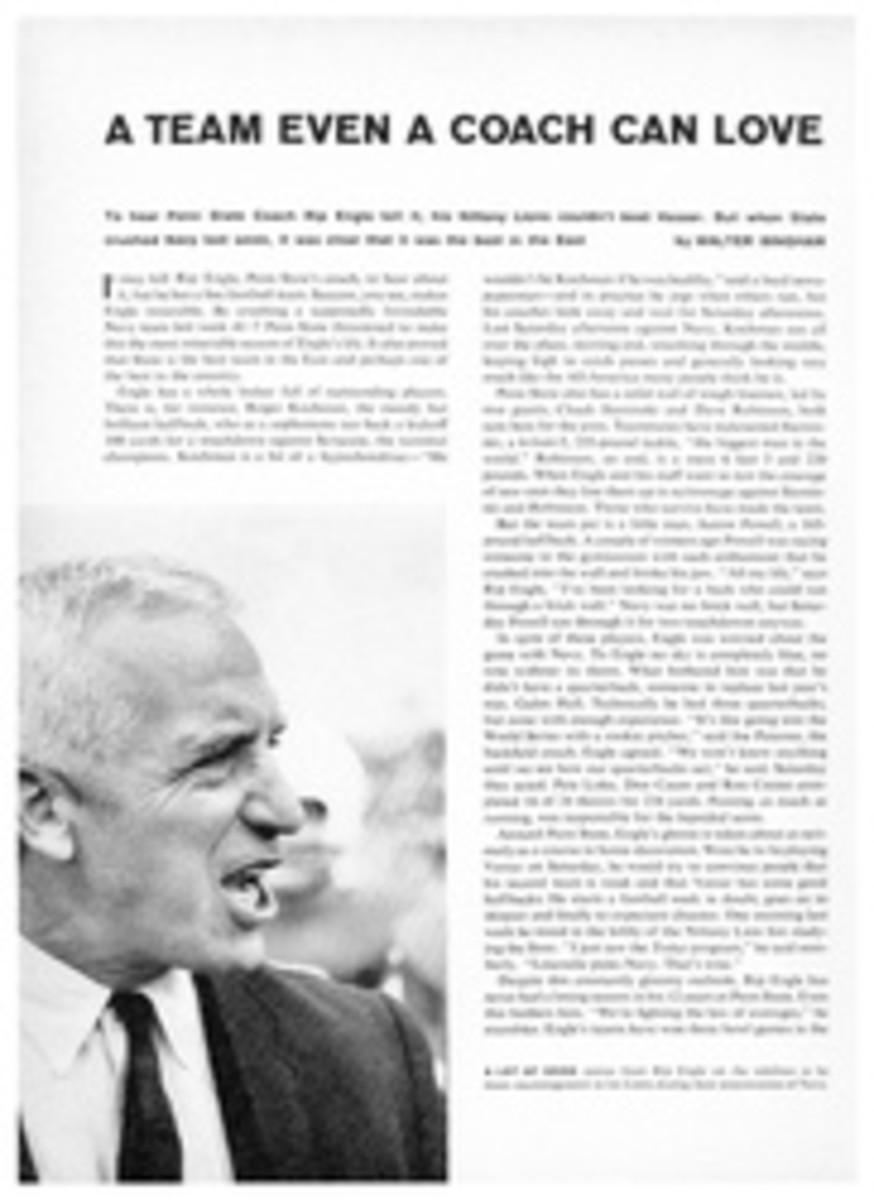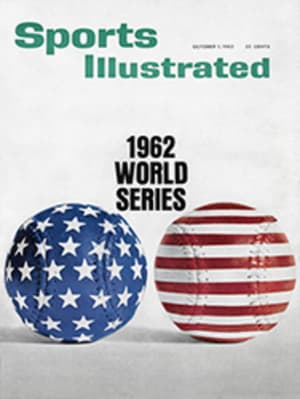
LOST IN A FOREST OF NEEDLES
The man who is bowing to the needling obstructions in the picture below is finding out what the country's best amateur golfers all learned last week: that the unrelenting and piny confinements of the renowned No. 2 course at the Pinehurst Country Club in North Carolina can destroy one's most sunsteeped dreams. The young man's name is Downing Gray, and at this very moment during the closing hours of the final round in the National Amateur golf championship he is starting to lose a seemingly safe five-hole lead.
When the 36-hole final match started last Saturday morning, even the most dedicated followers of golf had trouble identifying the two strangers who were standing in the positions usually occupied by the more celebrated names of this sport. One was Gray, a thin, 24-year-old insurance salesman from Pensacola, Fla. who had never before entered a national championship. The other was Labron Harris Jr., a lanky youth of 20 who comes from Stillwater, Okla., where he graduated with honors in mathematics from Oklahoma State University.
As these two obscure athletes prepared to tee off on the all-day grind that would determine the winner of the second most prestigious golf title in the U.S., the interest in the outcome was about on a level with the concern over whether it would rain that morning in Nome, Alaska. But by 3 o'clock that afternoon, the solemn Mr. Harris had demolished this indifference, along with his opponent's five-hole lead, by staging one of the most thrilling comebacks in the 62 years of the Amateur.
Gray had spent five exhausting and tension-filled days reaching the finals while beating nobody more famous than one Marion Methvin Jr. of Little Rock, Ark. Harris, on the other hand, had taken a much more spectacular route, beating Public Links Champion Richard Sikes, Homero Blancas of Houston, the runner-up in this year's collegiate championship, and then, in a wildly nerve-racking and seesawing 36-hole semifinal on Friday, Billy Joe Patton himself, the aging Bonnie Prince Charlie of amateur golf. As the afternoon round began, it looked for sure as if Gray's steady, workmanlike style, executed off an admirably compact swing, would get the Carolina gallery back to the clubhouse television set in time to watch home-state Duke play USC in the Blue Devils' opening football game of the season.
Harris had other ideas, however. Refusing to be ruffled by his deep deficit, he began to play nearly faultless golf. His long, lazy swing was moving the ball straight down the fairways for excellent distance; his chipping and putting could have won him a Marine marksman's medal. Playing the first eight holes of the afternoon—the 19th through the 26th of the match—in one under par, he won six, lost one and halved one to draw even. Gray, in the meantime, had lost most of the superb concentration that had served him so well throughout his first six matches of the tournament. He was spraying his drives far into Pinehurst's tall, long-leaf pines that surround the fairways like columns in a Grecian temple. His approaches and his putts refused to obey his will: Perhaps just a bit too soon, he had allowed himself the privilege of picturing a victory that was not yet his.
By the 28th hole Gray lapsed into his fifth bogey out of the 10 holes he had played thus far in the afternoon, and Harris went into the lead, 1 up. With immense determination, Gray regained control of himself and his game and proceeded to dam the flood of trouble. Even the appearance of General Eisenhower, who drove up in a bright-blue golf cart as the players reached the 12th hole, failed to faze Gray's new resolution—or Harris' poise—which is more than can be said for the gallery. For a while it wandered in schizophrenic disorder, attempting to give all its attention to both Ike and what was by now a tough, boiling golf match.
After the two players had hit their tee shots on the 15th, they were asked if they wished to meet Ike, who had to leave at that moment to catch a plane. Gray said he would prefer to wait until after the hole was finished. Harris told the referee, "Well, I might as well get it over with now." As he turned and walked back alone to where Ike was waiting, Harris, who has a most pleasing boyishness about him, muttered to himself: "Getting it over with is not exactly the way I meant to put it."
The gangly, 6-foot-3-inch youth mumbled his thanks as Ike said, "I didn't want to disturb you, but I wanted to congratulate you on the magnificent fight you have made."
Harris hurried back to his golf and salvaged a par out of the hole with a brilliant 80-foot chip shot. He birdied the 16th to go 2 up, then lost the 17th, a 187-yard par 3, to Gray's courageous and completely necessary par.
At the final hole—a longish par 4—Harris needed a four-foot putt for his victory, the kind of putt that makes it exceedingly hard to breathe. He gave it a good long look, and while the nervous crowd and his anguished opponent shifted uneasily under the leaden sky, he tapped it in. A porpoise's grin crossed his round boyish face for one of the first times that day, and he waved his long arms limply in the air.
"I'm kinda happy all right," he said self-consciously when they gave him the fussy gold trophy. "It's kinda hard to believe I was fortunate enough to win. I can hardly believe it."
A lot of other people felt the same way, for Labron Harris Jr.'s name is recognizable only because of his father, a sometime touring pro who coaches golf at Oklahoma State. Labron Jr.'s record contains nothing but such modest entries as Western Junior champion in 1960, and Oklahoma State champion in 1962. But his victory brought smiles to the faces of USGA officials as well as his own, for unlike so many of the best young golfers in the Southwest, Labron has not been using college golf as a kind of free, four-year prep school for the professional circuit. This week, as he celebrates his 21st birthday, he also will begin to study for his master's degree in statistics. Golf will now delay his education a bit. He has been named to the four-man U.S. team that will compete in the World Amateur in Japan this October. But then it is back to school for the new champ.
Those who have never followed the arduous six-day ordeal of the Amateur Championship of the U.S. Golf Association (as it is formally labeled) find it difficult to comprehend some of the qualities besides golfing skill that are needed for victory: the endurance to swim the English Channel underwater and the nerves to let your life savings ride on the double zero at Las Vegas would both be a help. Momentarily lacking one or another of these gifts, some of the best amateur golfers of this or any other generation were eliminated so early in last week's tournament that by Thursday morning's fifth round only two of the 16 golfers still in contention seemed very familiar.
One of these was Homero Blancas, a swarthy, black-haired, black-eyed Mexican-American who only five weeks ago had scored an unbelievable 55 in a tournament in Texas (SI, Sept. 3). Blancas had survived to the quarter-finals only by reason of a razor-thin victory on the previous day over Deane Beman, the 1960 Amateur champion, in the longest, wildest match of the week. Ten times in the first 18 holes the match seesawed back and forth—Beman 1 up, even, Beman 1 up, even, Beman 1 up, even, Blancas 1 up and so on until Blancas missed a tiny two-foot putt on the 18th green to send the players into extra holes. At this point, Beman's putter, widely respected as one of the most effective weapons in all golf, became as useless as a broomstick. As they halved hole after extra hole, Beman missed one short putt after another, any of which would have won the match. Finally, at the 24th hole, Blancas sank a 15-footer to win. Twenty-four hours later Harris put an end to Blancas' title bid.
Beman had plenty of company in this dour week for noted amateurs. Charlie Coe, who had twice won the tournament (in 1949 and 1958) and was runner-up by a stroke to Gary Player in the 1961 Masters, lost 3 and 2 to young Bill Gerringer of Newport News, Va. in his opening match. A similar misfortune struck Bill Hyndman, who has been one of our leading amateurs for more than a decade. Others who failed to get beyond the second round included former Walker Cuppers Ward Wettlaufer, Bill Campbell and Bob Gardner as well as Dudley Wysong, runner-up to Jack Nicklaus in last year's championship.
The finality of losing a match at the Amateur contains a poignancy that is absent from stroke-play tournaments, where even a golfer who is hopelessly out of contention can at least carry on as if all were well and perhaps even redeem his pride with a remarkable score the next day. In tennis this week's loser has next week's tournament to look forward to, or possibly a victory in one of the doubles events. But at the Amateur there is nothing left but the heavy burden of defeat and the long trip home. Convention requires the defeated to get out of the way, to remove their anguish from the clear and happy joy of the victor, and the all-week exodus of players from Pinehurst was a melancholy thing. The ways of the Amateur are harsh, but they add enormous drama to a great golf event. And if the memory is vivid of how a crestfallen Downing Gray lost a trophy in the pines, the winning smile of young Labron Harris is more vivid still.
PHOTO
ROBERT HUNTZINGER
DISASTER BEGAN FOR DOWNING GRAY WHEN HIS DRIVE ON THE 22ND HOLE LEFT HIM IN THE CLUTCHES OF NEARLY IMPASSABLE PINES
TWO PHOTOS
ROBERT HUNTZINGER
NEW CHAMPION LABRON HARRIS JR. LOOKS ANXIOUSLY AFTER A CRUCIAL SHOT ON THE FINAL ROUND—THEN GRINS WITH RELIEF

